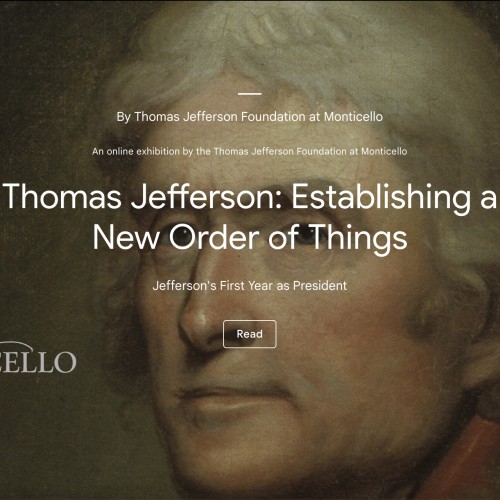Establishing a New Order of Things - Jefferson's First Year as President
An interactive look at Jefferson's consequential first year as President of the United States.
Thomas Jefferson lived in Washington, D.C., from late 1800 until his retirement from the presidency in March 1809. The story of his impact on the city, however, begins with the Compromise of 1790.[1]
Appointed Secretary of State by George Washington in 1789, Jefferson moved to New York in March 1790 to assume his position. Congress was then embroiled in controversy over the economic program introduced by Secretary of the Treasury Alexander Hamilton. Jefferson later described his role in bringing Hamilton and leading Congressman James Madison “to a friendly discussion of the subject.” Hamilton and Madison dined together, at Jefferson’s invitation, to discuss the assumption of state debts by the federal government. Hamilton’s proposal, opposed by most of the Southern states, favored the debt-ridden Northern states. Discussion and dinner, Jefferson recalled, “ended in Mr. Madison’s acquiescence ... that ... he should not be strenuous” in opposing assumption.[2] Realizing that assumption was a “bitter pill” for Virginia and other like-minded states, the negotiating parties agreed to soothe them with “the removal of the seat of government to the Patowmac.”[3]
The Residence Act of July 1790 provided for a national capital on the Potomac River and empowered President Washington to appoint commissioners to oversee the project. Washington turned to Jefferson and Madison for advice. Immediately, the creative Jefferson began to envision “the federal Capitol, the offices, the President’s house & gardens.”[4] Early in September 1790, Jefferson and Madison traveled from New York to meet with landowners in the designated area. In a memorandum written from Alexandria, Jefferson noted that he “supposed that 1500 acres would be required in the whole,” and that the ideal layout would be a rectangular grid.[5]
From 1790 through 1793, when he resigned as Secretary of State, Jefferson served as Washington’s “second in command” on matters concerning the capital. Through regular communication with Washington and the commissioners, Jefferson addressed every aspect of the project. His letters, memoranda, and reports covered land acquisition; surveys, boundaries, and plats; public buildings and bridges; a canal and wharves; domestic and foreign workmen; the sale of lots, financing, and additional issues as they emerged.[6]
Upon selection of a site in the vicinity of Georgetown, Maryland, Washington appointed French Major Pierre Charles L’Enfant to design the new city.[7] Washington and L’Enfant were well-matched. Both men dreamed of a monumental federal capital, one that would signify the strength of the national government. L’Enfant’s grandiose plan, embraced by Washington and ultimately imprinted on the landscape, called for 5,000 acres and radiating avenues between the primary centers of power.
Jefferson’s proposal for a modest town with a simple grid was quietly moved aside, but Jefferson himself maintained a key supervisory position. He provided L’Enfant with instructions to proceed to Georgetown and to immediately survey the area, requesting the Frenchman “to mark to me your progress about twice a week.”[8] By the summer of 1791, the two men were communicating about the layout of lots,[9] and early the following year, Jefferson was ready to embark on public works with Major L’Enfant.[10] During the winter of 1791-1792, however, differences had arisen between L’Enfant and the commissioners. Neither side was prepared to back down and the President charged Jefferson with dismissing L’Enfant from service.[11]
As plans for the federal district moved forward, Jefferson’s particular passion for architecture came into play. Early in 1792, the Secretary of State suggested to Washington that an architectural competition should determine the design of the President’s House. Jefferson himself prepared an advertisement announcing the competition and noting that a “Premium of 500 dollars” would be awarded for the adopted plan.[12] Some historians believe that Jefferson anonymously entered the competition, and an unattributed Palladian design does suggest Jefferson’s influence, if not his own contribution. The winning design came from President Washington’s favored candidate, Irish architect James Hoban.[13]
Simultaneously, Jefferson launched a design competition for the U.S. Capitol.[14] A year earlier, Jefferson had described for L’Enfant his thoughts about the legislative building. “I should prefer,” he explained, “the adoption of some one of the models of antiquity which have had the approbation of thousands of years.”[15] Jefferson prepared a sketch of a round design, based on the Roman Pantheon, to demonstrate what he had in mind. He was pleased, therefore, when a neoclassical submission from William Thornton met with Washington’s approval. Jefferson warmly praised Thornton’s design as “simple, noble, beautiful ....”[16] During the early stages of building, Jefferson worked directly with Thornton and with site architect Stephen Hallet;[17] during his presidency, he would work with architect Benjamin Latrobe on subsequent stages of the process.[18]
In November 1800, the President’s House was roughly ready for occupation and President John Adams was eager to take up residence. Adams was undeterred by reports of a muddy, rugged wilderness on the Potomac and a dwelling-place that resembled a construction site more than a presidential mansion.[19] As Adams’s Vice President, Jefferson had not been engaged on the capital project for several years, but he too had heard the dismal reports and had his doubts. Late in November, he joined Adams, nevertheless, as one of the first federal officials to live in Washington, D.C. “[W]e are better accomodated here than we expected to be,” he promptly notified his son-in-law, Thomas Mann Randolph, “and not a whisper or thought in any mortal of attempting a removal.”[20] Typically optimistic, he reported that Washington was “solidly established and this being now seen it will take a rapid spring.”[21]
Three months later, on March 4, 1801, Thomas Jefferson became the first president inaugurated in the new capital city. The Washington area sites listed below are associated with the years of his presidency.
- Nancy Verell, 8/1/14
- Sites compiled by Lucia Stanton, 3/94

An interactive look at Jefferson's consequential first year as President of the United States.
ADDRESS:
1050 Monticello Loop
Charlottesville, VA 22902
GENERAL INFORMATION:
(434) 984-9800